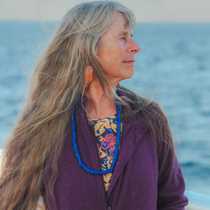Leconte Glacial Ice & The Town Of Petersburg, Alaska
On a gray on gray day with shades of dark green the Sea Lion made her way into the waters just off of the Stikine mud flats into LeConte Bay. Captain Graves dodged extremely large icebergs and found an area slightly ice-free and a good place to begin staging our morning’s activities. The deck staff and officers dropped Zodiacs in preparation for tours amongst large and small ice. Two signups were offered for any and all intrepid explorers wishing to float through one of the most beautiful sculpture gardens created by low tide and thousands of stranded pieces of ice; both very small and beyond measurement! Once the Zodiacs had a full complement of guests we headed out into the mists for a closer look at blue ice. The weather was slightly wet, very soft and perfect for intensifying the shades of blue reflected off of the icebergs. The tide was nearly at its lowest point this morning, the desired condition, giving us these fabulous views of many, many stranded icebergs, dripping, waiting for incoming tide or just the right amount of gravity to roll and break into a thousand pieces.
The Zodiacs were cruising approximately seven miles from the face of LeConte glacier, located fifty miles south of Juneau and twenty-two miles east of the town of Petersburg, Alaska. This tidewater glacier, covering an area of 188 square miles, is situated within the Stikine-LeConte Wilderness area, and is the most southern glacier in the northern hemisphere that calves into the sea.
In 1994, Paul Bowen a local schoolteacher from the town of Petersburg noticed an increase in the calving activity resulting in an enormous amount of icebergs in Frederick Sound. He and his high school students had been measuring the activity of LeConte Glacier since 1983. Mr. Bowen alerted scientists and a close watch, which continues today, began, as the retreat of LeConte glacier made it the fastest flowing glacier on Earth, moving at a rate of about ninety feet per day.
A few days before the arrival of the Sea Lion, a full moon brought extreme tides and this morning yet another very low tide brought a huge outflow of water from the front of LeConte glacier and along with many, many icebergs creating an otherworldly garden of shapes, colors, and sounds for our morning Zodiac cruises. Weaving in and out of ice, we found ourselves in a world both visual and auditory. Marbled murrelets sang across the waters, while the occasional harbor seal called for its mother. A loon’s eerie voice was heard over the water and from the trees the bald eagle’s screeching cackle could be heard through the mists.
The morning Zodiac tours ended all too soon and slowly the Sea Lion moved outside the terminal bar or outer most point where the LeConte glacier advanced many years ago. The bar is littered with a huge mound of rocks that were pushed by the front of the glacier and left as the terminal moraine from the snout of LeConte Glacier. Once everything was on board we began a short journey heading into the town of Petersburg located at the north end of Wrangell Narrows on the southeastern side of Frederick Sound. Our afternoon was spent exploring this small fishing community, including a short Zodiac ride to Kupreanof Island for our first walk in an Alaskan muskeg. The clouds lifted, dropped, lifted again giving the day some light rain, and a few moments of brightness. We remained in Petersburg for the afternoon and evening taking time to explore a working Alaskan town, the main occupation revolving around the sea. The Sea Lion was tied up at a dock and surrounded by a myriad of different types of fishing vessels. In celebration of the bounty of the Alaskan waters our evening meal was delivered to our ship in the form of live Dungeness crab. As the dining room doors were opened we adjourned from our evening’s recap and sat down to a traditional Alaskan feast of fresh caught Dungeness crab.




